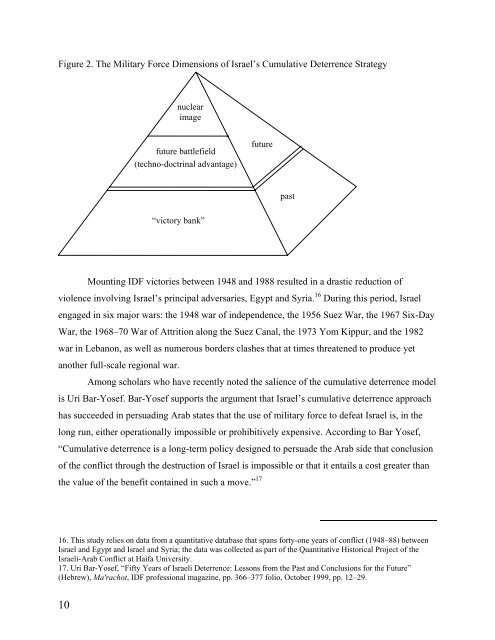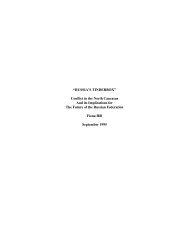Cumulative Deterrence and it's implementations to the War against ...
Cumulative Deterrence and it's implementations to the War against ...
Cumulative Deterrence and it's implementations to the War against ...
You also want an ePaper? Increase the reach of your titles
YUMPU automatically turns print PDFs into web optimized ePapers that Google loves.
Figure 2. The Military Force Dimensions of Israel’s <strong>Cumulative</strong> <strong>Deterrence</strong> Strategy<br />
nuclear<br />
image<br />
future battlefield<br />
(techno-doctrinal advantage)<br />
“vic<strong>to</strong>ry bank”<br />
future<br />
Mounting IDF vic<strong>to</strong>ries between 1948 <strong>and</strong> 1988 resulted in a drastic reduction of<br />
violence involving Israel’s principal adversaries, Egypt <strong>and</strong> Syria. 16 During this period, Israel<br />
engaged in six major wars: <strong>the</strong> 1948 war of independence, <strong>the</strong> 1956 Suez <strong>War</strong>, <strong>the</strong> 1967 Six-Day<br />
<strong>War</strong>, <strong>the</strong> 1968–70 <strong>War</strong> of Attrition along <strong>the</strong> Suez Canal, <strong>the</strong> 1973 Yom Kippur, <strong>and</strong> <strong>the</strong> 1982<br />
war in Lebanon, as well as numerous borders clashes that at times threatened <strong>to</strong> produce yet<br />
ano<strong>the</strong>r full-scale regional war.<br />
Among scholars who have recently noted <strong>the</strong> salience of <strong>the</strong> cumulative deterrence model<br />
is Uri Bar-Yosef. Bar-Yosef supports <strong>the</strong> argument that Israel’s cumulative deterrence approach<br />
has succeeded in persuading Arab states that <strong>the</strong> use of military force <strong>to</strong> defeat Israel is, in <strong>the</strong><br />
long run, ei<strong>the</strong>r operationally impossible or prohibitively expensive. According <strong>to</strong> Bar Yosef,<br />
“<strong>Cumulative</strong> deterrence is a long-term policy designed <strong>to</strong> persuade <strong>the</strong> Arab side that conclusion<br />
of <strong>the</strong> conflict through <strong>the</strong> destruction of Israel is impossible or that it entails a cost greater than<br />
<strong>the</strong> value of <strong>the</strong> benefit contained in such a move.” 17<br />
16. This study relies on data from a quantitative database that spans forty-one years of conflict (1948–88) between<br />
Israel <strong>and</strong> Egypt <strong>and</strong> Israel <strong>and</strong> Syria; <strong>the</strong> data was collected as part of <strong>the</strong> Quantitative His<strong>to</strong>rical Project of <strong>the</strong><br />
Israeli-Arab Conflict at Haifa University.<br />
17. Uri Bar-Yosef, “Fifty Years of Israeli <strong>Deterrence</strong>: Lessons from <strong>the</strong> Past <strong>and</strong> Conclusions for <strong>the</strong> Future”<br />
(Hebrew), Ma'rachot, IDF professional magazine, pp. 366–377 folio, Oc<strong>to</strong>ber 1999, pp. 12–29.<br />
10<br />
past
















